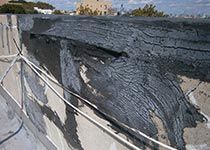 Tar prevents masonry from breathing, trapping water inside and creating cracks.
Tar prevents masonry from breathing, trapping water inside and creating cracks.
Because roofs are regularly subjected to rain, wind, snow, ice, and blistering sun, they require as much if not more care and feeding than most building systems. Yet, the roof is one area where boards all too often put off necessary maintenance and repairs or opt for short-term fixes in a misguided attempt to save money.
Keep in mind that a roofing system is more than just its membranes. Roof maintenance must address not only the protective layers covering the underlying roof deck, but also the roof-level components, such as parapets, copings, base flashing, counterflashing, bulkheads, chimneys, railings, drains, scuppers, etc., all of which are exposed to the elements and therefore vulnerable to water infiltration. Repairing a worn roofing membrane will not stop leaks if water is entering through cracks in a parapet wall or seeping underneath the roofing layers because of defective or missing counterflashing.
Tar None
A common but ultimately detrimental method of roof "maintenance" is to apply tar everywhere at the roof-level, including on parapets, coping stones, bulkheads, and other masonry. Tar (asphalt) acts as an effective sealant on roofing membranes but not on masonry, which needs to breathe. It prevents stonework and brickwork from releasing the incidental moisture that they naturally absorb. Also, tar eventually melts and cracks, creating pockets that act as a conduit for more water to enter. Trapped water freezes and expands, creating more cracks, loosening bricks and stones, and weakening the structural integrity of the masonry, making a bad situation worse.
Don't Cap It Off
Another overused and ultimately futile maintenance practice is repeatedly "capping" a roof by applying a new membrane on top of the existing layers. Cap sheets can add a supplemental level of waterproofing if the underlying roof structure is generally sound. But in too many cases, cap sheets are applied on top of badly deteriorated membranes, trapping saturated water. In addition, the new membrane will not adhere properly if the underlying layers are peeling, bubbling, fraying, or otherwise defective. Repeated layers of cap sheets can also distort the pitch of the roof, disrupting drainage and causing ponding.
A regular roof maintenance program is still required even if the roof is under warranty.
While capping a roof is much less expensive than tearing up the existing roof down to its deck and completely replacing the membranes (approximately $5 a square foot vs. $17 to $20 a square foot), capping provides only temporary relief because it doesn't fix the underlying defects. Furthermore, manufacturers may give a limited pro-rated warranty for a cap sheet, but you will be unlikely to receive the type of long-term No Dollar Limit (NDL) warranty typically provided on a full roof replacement.
Maintenance Items
Of course, even if you've repaired defective roof-level masonry and replaced the roof itself you can't forget about the roof for 20 years until the NDL is up. A regular roof maintenance program is still required and should include checking for the following items:
- Cracked and loose masonry and open mortar joints.
- Torn membrane and loose seams.
- Debris and sharp objects that could puncture the membrane.
- Ponding and clogged drains.
- Base flashing separated from parapet walls.
- Missing or defective counterflashing.
- Recreational use of a roof not designed for such activities.
From the May 2005 issue of Habitat magazine.
